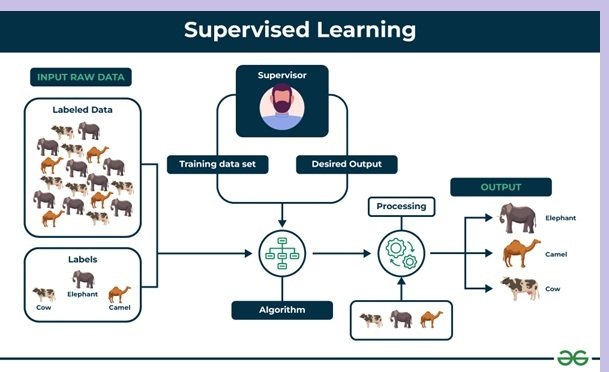Difference Between Supervised and Unsupervised Learning

difference between supervised and unsupervised learning
Introduction
Machine learning (ML) is one of the most transformative technologies of the 21 century. At its core, ML allows systems to learn from records and enhance their overall performance without explicit programming. Within machine learning, foremost sorts dominate the landscape: supervised learning and unsupervised learning. Understanding the difference among those processes is important for anybody diving into AI, information technology, or analytics.
In this article, we’ll give an explanation of what supervised and unsupervised learning are, explore their key variations, benefits, obstacles, examples, and applications, and provide FAQs to assist in making clear common doubts.
What is Supervised Learning?
Supervised mastering is a type of device that learns from a set of rules and is educated on categorized data. In less difficult phrases, the machine is provided with input statistics and the corresponding output or “correct solution.” The model learns to map inputs to outputs and can then make predictions on new, unseen statistics.
Key Characteristics of Supervised Learning
- Requires categorised datasets
- Uses ancient statistics for education
- Predictive in nature (can predict outcomes)
- Works for class and regression tasks
Examples of Supervised Learning
- Email Spam Detection: Classifying emails as unsolicited mail or not unsolicited mail based on classified examples.
- Credit Scoring: Predicting whether a person is eligible for a loan.
- Stock Price Prediction: Using historic rate records to forecast future costs.
- Medical Diagnosis: Predicting diseases from patient facts.
What is Unsupervised Learning?
Unsupervised learning, however, works with unlabeled statistics. The algorithm attempts to pick out patterns, relationships, or structures inside the information without predefined outputs. Instead of predicting, it makes a specialises of grouping comparable information or locating hidden insights.
Key Characteristics of Unsupervised Learning
- Works with unlabeled datasets
- Exploratory in nature (reveals hidden styles)
- Can cluster, reduce dimensionality, or locate associations
- Commonly used for records analysis and anomaly detection
Examples of Unsupervised Learning
- Customer Segmentation: Grouping clients primarily based on purchasing conduct.
- Market Basket Analysis: Finding product associations in retail transactions.
- Anomaly Detection: Identifying uncommon transactions in banking.
- Image Compression: Reducing the scale of images at the same time as keeping vital functions.
Key Differences Between Supervised and Unsupervised Learning
FeatureSupervised LearningUnsupervised LearningData TypeLabeled dataUnlabeled dataObjectivePredict outcomesIdentify patternsExamplesClassification, RegressionClustering, AssociationGuidanceRequires human supervisionNo supervisionComplexityModerate to highHighApplicationsEmail spam detection, inventory predictionCustomer segmentation, anomaly detectionOutputKnown goal variableHidden shape or grouping
Types and Techniques
Supervised Learning Techniques
- Classification: Assigning inputs into discrete classes.
- Example: Predicting if a tumour is benign or malignant.
- Regression: Predicting non-stop outcomes.
- Example: Estimating house fees primarily based on capabilities like length and location.
Unsupervised Learning Techniques
- Clustering: Grouping similar data factors collectively.
- Example: K-Means, Hierarchical Clustering.
- Association: Finding relationships among variables.
- Example: Market Basket Analysis.
- Dimensionality Reduction: Reducing the variety of variables whilst maintaining vital information.
- Example: Principal Component Analysis (PCA).
Advantages of Supervised Learning
- High accuracy in prediction tasks
- Easier to evaluate version performance
- Works well whilst historical facts are available
- Useful for class and regression issues
Limitations of Supervised Learning
- Requires huge, categorised datasets, which may be costly
- Overfitting is possible if the model is just too complex
- Cannot discover hidden styles beyond the categorised facts
Advantages of Unsupervised Learning
- Can deal with unlabeled statistics
- Discovers hidden styles within the dataset
- Useful for exploratory data evaluation
- Helps in dimensionality discount and clustering massive datasets
Limitations of Unsupervised Learning
- Harder to assess consequences as compared to supervised learning, knowledge of
- Less accurate for prediction responsibilities
- Requires more complex algorithms and computing energy
Applications in Real Life
Supervised Learning Applications
- Healthcare: Predicting patient results primarily based on ancient health facts
- Finance: Fraud detection and credit scoring
- Retail: Predicting client churn
Unsupervised Learning Applications
- Marketing: Segmenting customers for targeted campaigns
- Cybersecurity: Detecting anomalies in network visitors
- E-trade: Recommending merchandise based on consumer behaviour
How to Choose Between Supervised and Unsupervised Learning
- Availability of Labelled Data:
- If categorised data is available, supervised learning is favoured.
- Objective of Analysis:
- If the goal is prediction, pick supervised learning.
- If the goal is sample discovery, pick unsupervised learning.
- Complexity of Task:
- Unsupervised studying is extra exploratory and may require complex preprocessing.
FAQ
1. What is the primary difference between supervised and unsupervised mastering?
- Supervised learning makes use of classified information to predict effects, while unsupervised learning works with unlabeled statistics to discover hidden patterns.
2. Can a model use both supervised and unsupervised learning to gain knowledge of?
- Yes, this is called semi-supervised learning, in which a small quantity of categorised statistics guides the learning process in the presence of large unlabeled datasets.
3. Which is higher: supervised or unsupervised learning?
- It depends on the challenge. Supervised learning is better for prediction, at the same time as unsupervised learning is ideal for exploration and pattern discovery.
4. What are examples of supervised learning algorithms?
- Linear Regression, Logistic Regression, Decision Trees, Random Forest, SVM.
5. What are examples of unsupervised studying algorithms?
- K-Means Clustering, Hierarchical Clustering, Principal Component Analysis (PCA), Apriori Algorithm.
Conclusion
Understanding the difference between supervised and unsupervised learning is fundamental for every person running in AI, gadget gaining knowledge of, or information science. Supervised learning specialises in predicting the usage of labelled information, whilst unsupervised learning seeks patterns in unlabeled data. Both strategies have their precise advantages, obstacles, and programs. By choosing the proper method primarily based on your dataset and desires, you may release treasured insights and construct powerful machine learning models.
Read More:-








1 thought on “Difference Between Supervised and Unsupervised Learning”